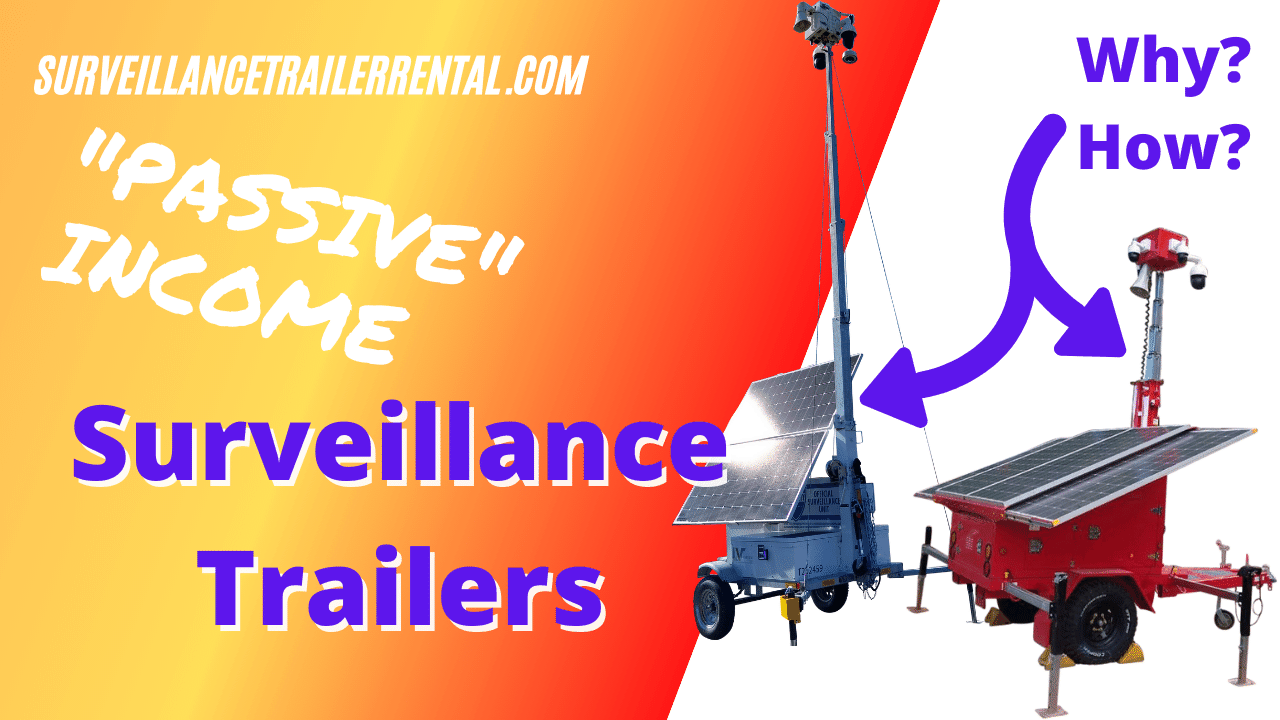Top 15 Features of a Mobile CCTV Trailer
A mobile CCTV trailer is a useful tool for anyone looking to earn semi-passive income by providing live-monitored video surveillance around a business, construction sites and off-grid locations.
They usually come with advanced features to make deploying and servicing them fast and easy.
A mobile CCTV trailer is ideal for temporary or rapid deployment. It is perfect for military, law enforcement, education, emergency management, construction, crowd control, transportation, mining, and so on.
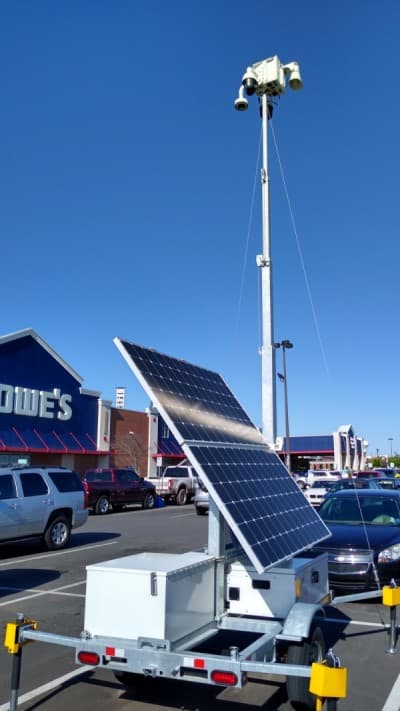
Security integrators with technical experience who are looking to build or buy surveillance trailers to sell or rent to their customers should consider mobile CCTV trailers that are rugged and suitable enough for long-term field use.
Other features to look out for include tamper alarms, redundant communication paths like dual-carrier cellular, CCTV cameras such as fixed, thermal and PTZ optical cameras for long-range detection, and folding or telescoping mast for wider camera range which are vandal-proof.
Top Features of Mobile CCTV Trailers
#1 | QUICK DEPLOYMENT
A mobile CCTV trailer should be built for easy and quick deployment.
[mks_col] [mks_one_half]It should be designed such that it can be set up by a single person within minutes. The components must be designed for quick install which means it should only take a few seconds to install the lights, cameras, antennas, motion detectors, and so on.[/mks_one_half] [mks_one_half]
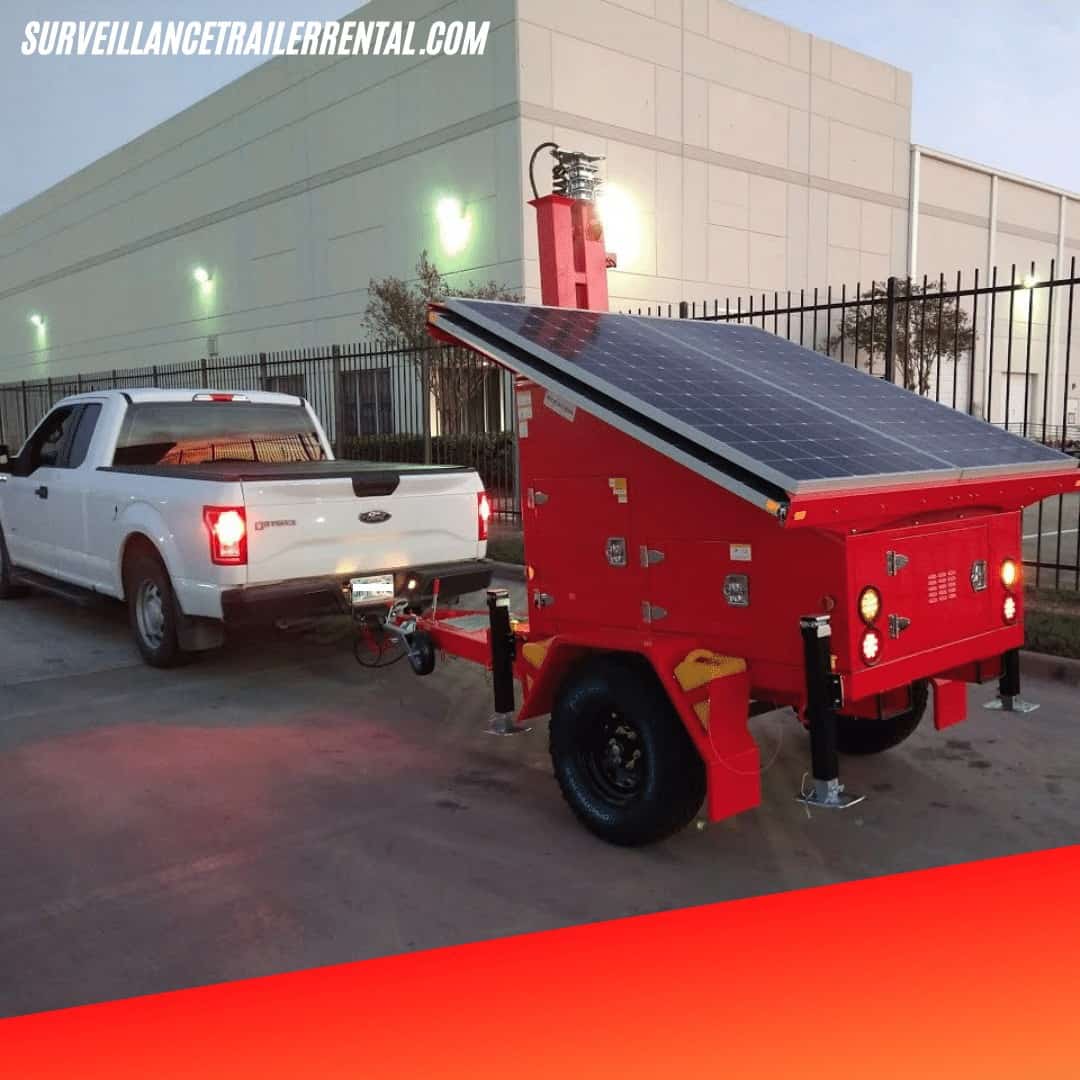
[/mks_one_half] [/mks_col]
For communications and power, it should use electrical connectors that are weatherproof.
Using weatherproof electrical connectors create room for rapid installation and replacement of cables when necessary.
The solar panel modules must be designed such that they can be added or removed easily by a single person.
#2 | CONNECTIVITY
[mks_col] [mks_two_thirds]
Video monitoring and remote control should be available through point-to-point wireless system or cellular connections.
The type of connection used is usually dependent on the location of the trailer. Some locations may have cellular connections availability, some may not, and others may or may not have Wi-Fi available.
[/mks_two_thirds] [mks_one_third]
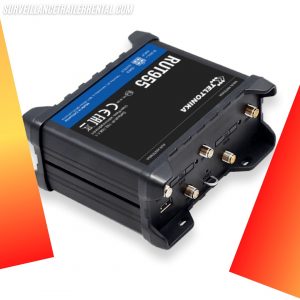
[/mks_one_third] [/mks_col]
#3 | EASILY CONFIGURABLE
A mobile surveillance trailer must be easy to configure and re-configure. The system should be engineered such that it gives room for future changes.
It’s important to be able to quickly and effortlessly swap internal components if they fail or need to be upgraded. For example, if the cellular modem needs to be upgraded, the replacement should be a seamless process. The component should be physically accessible without disassembling other components or disconnecting wiring from the power system. Also, a process should be in place to transfer software configurations and settings to the new device but that’s out of scope for this article.
#4 | PHYSICALLY STABLE
Great emphasis should be placed on the trailer’s stability. An unstable platform will buffet under the wind.
This could result in unclear camera images and causing the system to save more video data.
The outriggers and braces must be adjustable to produce a more robust stance when deploying.
#5 | VIDEO MANAGEMENT SYSTEM (VMS) SUPPORT
The VMS needs to support functionality like two-way audio and video analytics integrations.
Since these are off grid systems, the hardware needed to run the VMS is super important because a beefy PC will consume way more power than a basic Linux server.
However, the VMS you need may not run on Linux.
You’ve gotta figure all this out and factor it into your load calculations before selecting a surveillance trailer and the components of its power system.
#6 | SIMPLE OPERATION AND EASY-TO-SETUP
The operations of the system of a mobile surveillance trailer must be quite simple and shouldn’t require tools to setup.
Security integrators should look out for surveillance trailers with systems that become operational with a simple press of a button.
The system should be designed with controls that are easy to understand and indicators that quickly show if the system is operating correcting before the operator leaves the site.
#7 | EMERGENCY OPERATIONS
Surveillance trailers should be designed with technologies that give room for quick deployment in situations where incidents/events might require remote monitoring.
The trailer should be designed as a perfect tool for first responders to crime scenes and major disasters.
#8 | EXTRA STORAGE FOR CAMERAS AND ADDITIONAL EQUIPMENT
A mobile security trailer should offer a custom on-board travel rack to securely hold cameras and additional equipment when traveling or moving about.
It’s a really bad idea to tow one of these security trailers down an interstate with the cameras mounted to the mast. The only benefit is being able to yell at other drivers over the loudspeaker while you’re enroute.
#9 | ELECTRIC BRAKES
Some mobile CCTV trailers have an electric braking system.
This is particularly needed for its safety when towing and also to hold it in place during deployment.
The braking system should have an individual brake control and battery backup for ease of use. This feature isn’t absolutely necessary, but it’s nice to have.
#10 | POWERED TO SUPPORT LONG-TERM USE
A mobile CCTV trailer should be able to power the entire load for at least 1 week without sunlight or fuel.
It should have a generator system that is fully automatic. Depending on the total load, the system should be able to operate for up to 60 days with the generator system using less than 20 gallons of fuel.
The power platform will typically need at least 1200W of solar panels.
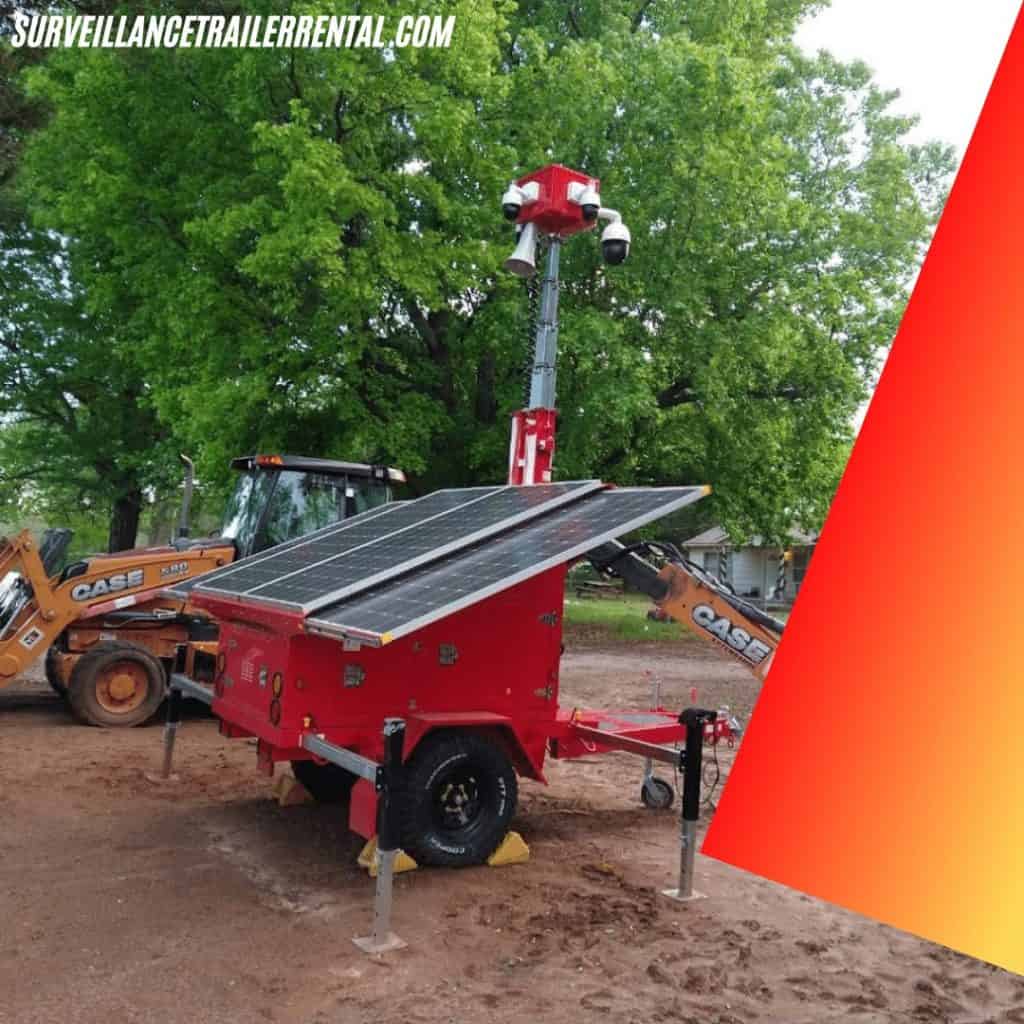
#11 | FUEL-BASED GENERATOR FAILOVER
It should have an automatic generator system that kicks on when the battery bank drops below a threshold voltage.
This automatic generator failover system is crucial to maintaining operations over a long-term. The AC generator should be able to provide power to charge batteries and other equipment external to the system.
#12 | BATTERY POWER STORAGE
The battery bank needs to be sized in a way that makes sense for the load, desired runtime, and desired recharge rate.
Typically, we want the batteries to return to float inside the period of time when the sun is producing peak power. Usually, we try to float the batteries using the solar panels within 6-8 hours.
The best possible battery package is usually provided using the modern AGM – SLA battery technologies. When looking for battery support, LiFePo is possibly the best with a perfect balance of size, weight, and performance.
However, top-quality AGMs such as Fullriver or LifeLine are also excellent.
For trailers using lead-based batteries, ensure that they are classed as top performance with each battery having a rating of at least 100Ah, 12VDC with minimum of 100-hour discharge rate at 1 Amp.
The batteries should be designed to store energy over a long-term and should have a negligible internal discharge rate.
The batteries should have a discharge cycle rate up to a minimum of 300 cycles. Their temperature ratings must be excellent such that they can endure both extremely high and low temperatures.
Check the batteries to ensure that they are sealed flame-retardant. They should have little to no gassing, ensuring a slim chance of the batteries corroding the system. The batteries should be top quality and guarantee an excellent source of power retention.
Read more about prolonging the life of your battery.
#13 | RECORDING OPTIONS
Most CCTV trailers come with 3 common recording options for CCTV videos.
Depending on the deployment required, some manufacturers could support more than one recording option. These options include:
- Local or Edge Storage: Video is stored on the cameras’ SD cards or on a local PC/ Network Video Recorder (NVR) mounted in the trailer.
- Straight-to-Cloud: Videos are recorded directly to cloud servers. This recording option is usually triggered when there is an alarm or occurrence of an event. This improves the effectiveness of video analytics. Beware of cellular data consumption.
- Cloud-as-Backup: It could be a bit expensive to continuously upload videos to cloud servers over cellular connections. Some manufacturers provide manual remote upload to cloud servers. In a case where uploaded video might need to be viewed, viewing over cellular connection is eliminated once the video is stored in the cloud.
#14 | ADDITIONAL POWER CAPABILITIES
A mobile CCTV trailer should have high power availabilities for custom hardware configurations.
The system should have additional higher power receptacles for low voltage (12VDC) which allows for other hardware such as external inverters, cellular hardware, high-powered LED lighting, communications hardware and higher power computers.
Power is typically made available via terminal blocks for DC-powered devices and inverter with a power strip for AC-powered devices.
#15 | POWER MANAGEMENT
Ideally, a mobile CCTV trailer uses a power controller/monitor which is network-connected that manages battery charge cycles, monitors the health of the battery and power systems, and switches between power sources.
Some trailers offer cloud services which the power controller interacts with to remotely troubleshoot (restart, reconfigure, reboot) and monitor the health status of the equipment.
Each mobile surveillance trailer come with 3 powering options.
Each source of power is used in charging batteries and powering the equipment. They include:
- Solar: Solar panels make up the most common source of power for surveillance trailers. The influx of newer panels with reduced cost and size has driven its efficiency.
- Backup Generator: This is a popular redundant power source in areas with limited sunlight. It is hard to solely rely on solar power in these regions. Usually, the generators become operational when the charges of the battery dips beyond a set value. Backup generators are designed to turn off once there is strong solar power generation.
- Grid Powered: This is option is not so common. It is not available over a long-term. It is only limited to deployments in regions where grid power is available. In areas where grid power is available, it can be used as a solar power backup to charge batteries.
OPTIONAL FEATURES
HARSH WEATHER OPTION
A mobile surveillance trailer should have the option to completely insulate full body enclosure and also the floor.
By insulating the body enclosure, the trailer is able to maintain the hardware’s internal temperature during extremely cold or hot weather conditions.
In hot weather conditions, the trailer is designed such that the automated fan systems use the air under the unit to cool down the enclosure.
For extremely hot conditions, the system might be designed to support an air conditioner situated on the rear wall or on the roof of the trailer (location is dependent on the presence/absence of solar panels). In this case, the generator will usually be leveraged more.
In cold weather conditions, the generator system is designed to provide heat.
Once the temperature of the enclosure gets below 32°F, the generator can take over to serve as heat source. The main closure would be flooded with heat from the opening of the heat vent system till it reaches ~80°F.
Temperature control is more of an issue when using non-industrial hardware or LiFePo batteries.
Be sure to check operating temperatures on the datasheets of all hardware and consider installing temperature sensors that can be remotely checked as part of health and status so you can get ahead of potential problems.
It should be noted that an insulated trailer compartment will hold a significant amount of heat from internal component dissipation alone.
REMOTE CONTROL, STATUS AND VIDEO MANAGEMENT SYSTEM SUPPORT
An ideal CCTV trailer should provide a strong level of control and status functionality.
A complete system is one that allows status indication which include: battery current, communications status, enclosure temperature, battery voltage, GPS location, electronics temperature, fuel level, door tamper notification, generator status, solar amps, generator enclosure temperature, fan statuses, and additional inputs that could be used for functions such as motion detectors.
The system should equally have additional outputs that is useful for functions such as sirens, control lights, and so on.
Different manufacturers have varying Status Technology for their remote control and status. All resources can be checked on their individual websites.
SOLAR RECHARGING SYSTEM
There are mobile CCTV trailers on the market with an optional solar recharging system.
They might be marketed as portable accessories to boost the solar output in deployment scenarios where sunlight is limited.
They are usually placed on top of the core trailer enclosure. This provides a solar-powered recharging system which is easily transportable with the trailer and can be readily deployed when necessary.
Look out for trailers with a deployment system that is easy-to-use – ‘Fold and Go.’ Ensure that the panels are sturdy and durable.
For added security, ensure that the panels are designed to face down when folded. Under the right weather conditions, the solar array of any trailer should be sufficient enough to continuously run any typical configuration.
SYSTEM STATUS INDICATORS
This optional feature is a remote control and monitoring service that allows users to view critical information about the trailer on the field.
Status monitoring includes items such as system draw, fuel level, battery amps, generator operation, GPS location, battery voltages and temperatures of major components.
Some trailer’s status indicator feature goes beyond just providing access to input and relays status, they also allow users to control these relays remotely, providing the user the ability to turn on audio, lighting and other available devices on the system.
Being able to restart critical electronic components is a very important feature especially when your trailer is remotely deployed.
SENSOR AND CAMERA OPTIONS
The most common and reliable camera type used when deploying mobile CCTV trailers are PTZs.
They are usually adjusted to automatic guard tours. They use sensors or secondary cameras to control the direction which the PTZ is focused.
For example, use fixed lens cameras to trigger the PTZs to “snap-to” a preset location and auto-track an intruder. Mechanical PTZ controls should be used on a limited basis as they pull a lot of amps when they are being maneuvered.
If you need a persistent patrol mode activated, be sure you factor the max power consumption during PTZ operation into your load calculations when building the mobile CCTV trailer.
Other reliable secondary sensor/camera options to consider include radar, thermal, gunshot detection, LPR and fisheye cameras, and so on. Also, look out for cameras and sensors that offer steady visible or strobe light for deterrence with central station monitors for 2-way audio communications.
CONCLUSION
Other features to look for in trailers include ones having more solar panels than you may need which is managed by solar controller and can also be powered by diesel generator.
You can consider trailers with sufficient video storage capacity, several light sources, two-way audio, infrared spot and floodlights, visible floodlights, siren, long range Wi-Fi, access control of the trailer systems, embedded PA system, video help point and an alarm panel having 360 degrees Passive Infrared (PIR) sensor for detection of movements around the trailer.
In conclusion, as an entrepreneur or security integrator looking to buy surveillance trailers to rent to your customers, it is important that you prioritize the durability and rigidity of the trailer to withstand different adverse conditions above anything else.
Have in mind that the trailer would require to be moved around a lot under different traveling conditions to diverse locations with adverse weather conditions.
You could find yourself always needing to make repairs or even having to buy a new trailer within a short period if you purchase a trailer that’s not very durable.
In addition, factor the requirements of your preferred customers in your purchasing decision, and if possible, buy more than one trailer.
This will ensure that you’re likely going to have a trailer that matches the specifications and requirements of any target customer.
Also, you’ll be able to test and train on one unit in the event that your entire inventory isn’t deployed to the field. With this, you ensure that you never run out of trailer availability for customers looking to rent.
You’re only going to get more referrals when your trailers are readily available and your customers experience short lead times.




